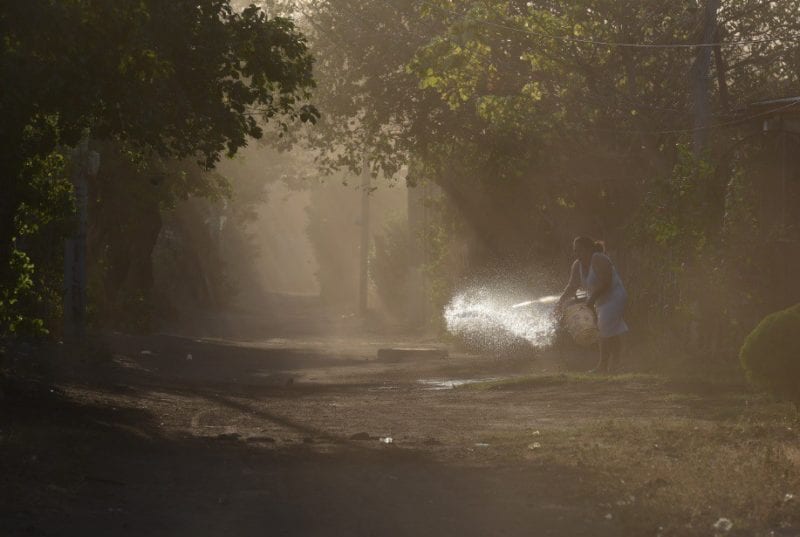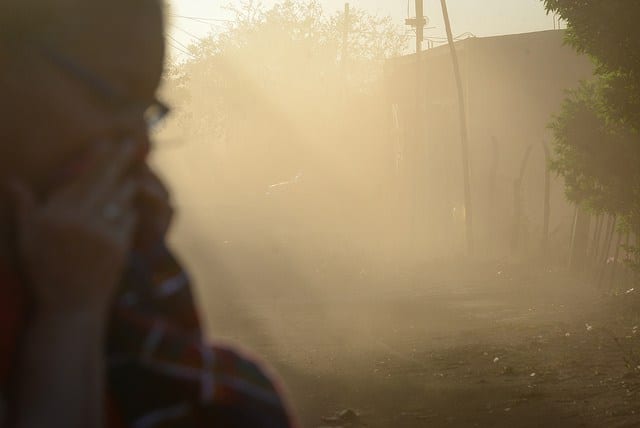Leon, Nicaragua Faces Dust Storm Crisis
Residents complain of adverse health effects while alternatives of reforestation, irrigation or crop rotation are being weighed.
By Maynor Salazar (Confidencial)

HAVANA TIMES – When the wind blows strong in León, the sky changes color. Doors and windows slam shut. Darkness swallows the daylight and dust falls like ashes over the houses, buildings, churches and offices.
In the last few years in this department, the phenomenon of the dust-storms has worsened greatly; veritable tempests of dust and dirt carried by the wind. The problem originated in the 1950s with the cotton monoculture: “At that time there was a brutal degradation of the soil and abuse of pesticides; they plowed the land as many times as possible, and left no trees standing to break the winds,” explains Gill Blass, agricultural engineer, ecologist and resident of the Sutiava neighborhood in León.
The drop in international cotton prices greatly lessened its cultivation and mitigated the problem. At that time, the government carried out a reforestation campaign. Nevertheless, cotton was largely replaced by peanut cultivation, and over the last decade, this didn’t change the form of working the soil. Now climate change is aggravating a serious problem for the population of León.
Down to the last stubble
The soils of the Pacific region of Nicaragua are the most exploited in the country. Nationally, peanuts are grown on 65,000 manzanas (1 manzana = approx.1.68 acres or .705 hectares). Of these, 20,000 are in León, 35,000 in Chinandega and the other 10,000 are split between Managua, Masaya and Granada.
In contrast to Chinandega, Managua, Masaya and Granada, the department of León is surrounded by those 20 thousand manzanas with no rows of trees to serve as wind-breaks and help contain the dust. The use of heavy machinery to pulverize the soil facilitates the frequent appearance of these dust-clouds in the city.
“They utilize three different machines in the process of harvesting the peanuts. One lifts the soil to detach the nut. Another opens the shell, and yet another machine pulls the stubble, which they pack and sell for cattle feed”, explains José Mendoza, biologist and León resident.
The peanut producers exploit the soil to the fullest. In addition to collecting the stubble (the remains of stems and leaves that are left in the field after cutting the plant and that could serve as nutrients for the earth’s crust) to sell, they rent their farms out for grazing so that the cattle can eat the “leftovers of the leftovers.” “As a result, no vegetation at all is left on the ground, making it easy for the wind to lift up the dust and carry it off,” the biologist indicates.

Irrigation vs. water shortage
Carlos Abaunza, peanut producer and member of ADAL, the Association of Leon Farmers, accepts that the problem of the dust storms is related to the cultivation of this legume, the lack of natural wind barriers in the zone and specifically to the lack of irrigation on the farms.
“The best remedy for the dust storms, beyond the natural wind-breakers, would be to have irrigation coverage all year. Unfortunately, irrigation hasn’t increased in our zone. During the dry season the soil is bare, so when the winds increase they carry the dust. That’s why this year we’re having greater dust storms,” Abaunza notes.
For the peanut growers, the irrigation system represents an alternative for lessening the soil’s fragility. “But there are producers who only plant on rented land. This doesn’t let you put in irrigation, because it’s a long-term investment,” Abaunza continues. He does feel that there’s enough water in the watersheds to install this system.
On a national level, only 10 percent of the total area registered for peanut cultivation is irrigated, according to the registries of the Nicaraguan Union of Agricultural Producers. Even though this technique is considered an option to mitigate the dust-storms, Carlos Rivas, ecologist and soil specialist, assures that this can’t really serve as an alternative since deforestation has affected the watersheds, and these are nearly dry.
“There’s no infiltration, there’s no refilling from the groundwater that feeds some of the important rivers in the Pacific zone, and currently these riverbeds are just rocks,” declares the ecologist.
Faced with the lack of water, last year Comandante Daniel Ortega’s government promised a reforestation campaign to plant rows of natural windbreakers that could put the brakes on the dust storms. Confidencial visited the peanut farms in the territory, but found no evidence of this program.
“Supposedly the campaign to restore the natural wind-breakers was going to be launched last year. But where are the trees?” wondered Carlos Rivas. “If any were planted, then they weren’t given any follow-up. They didn’t consider the fact that we are in the grip of an extreme climatic phenomenon.”
Confidencial requested comments from MARENA (Ministry of the Environment and Natural Resources), INAFOR (National Forestry Institute), and the Leon mayor’s office, but none of the state institutions offered information.
The citizens of Leon manifest their unhappiness with the government and environmental authorities, and also with the peanut producers. To confront this phenomenon, a large concerted effort is required from among all these sectors, but thus far there’s been no solid and concrete initiative.
Biologist José Mendoza advocates for crop diversification. “The natural wind-breaks are a good way of protecting the soil, but there also has to be crop rotation, and not always just peanuts. That would help conserve the soil.”
But the peanut growers aren’t willing to stop planting. Carlos Abaunza, ADAL representative, assures that they can’t stop planting their land since that there’s no other option for income. In this area, tourism hasn’t been programmed or developed, he noted.
“It disturbs me to see the dust-storms in León and these are barriers to tourism. In UPANIC we are watching and talking about bringing in some experts to see what can be done,” said Abaunza, adding that “it’s hard, but hopefully in ten years we’ll have eradicated the dust-storms and be able to speak more positively.
There are methods of soil conservation, and a series of alternatives that are right at hand for the small businessman. You need to work on the reforestation of the watersheds. We’re at a critical point and if we don’t do it, we’re going to regret it,” concludes ecologist Carlos Rivera.
Penned in by the Peanut Fields
The William Fonseca suburb is located to the north of León. It’s fenced in by fields of peanuts. When the winds are strong, the place is swallowed in a cloud of dust.
Beatriz Turcios is a resident of this suburb. Her 11-month old son is one more statistic in the count of respiratory illnesses registered in the AMOCSA Social Security clinic.
Speaking to us at home, Beatriz explains that her baby has asthma and the dust coming from the peanut fields provokes pneumonia and bronchitis in him. “The doctor told me that if he continues this way they’re going to have to admit him as an overnight patient again,” relates the anguished mother.
Five days following our initial interview in her house, Beatriz did have to have her son admitted. “The dust on Saturday and Sunday was bad, there were dust storms and that affected him again. It’s not easy for me to have him in a bed here, it’s very painful as a mother, but that’s how it is with so much dust in our neighborhood,” Beatriz affirmed.
There’s one general hospital in León and two Social Security clinics. One of them is AMOCSA, the one that Beatriz uses. This clinic has reported 2,350 cases of respiratory illness during 2016. We were unable to obtain the overall statistics for the department of León from the Ministry of Health.
Juan José Zapata, a pediatrician from the AMOCSA clinic, did inform us that the increase in patients with respiratory illnesses as a result of the dust storms is notorious. “All this occurs because of the exposure to dust,” he explains.
“At the moment, this is affecting us, but what’s going to happen to our children? Day and night we’re breathing in dust,” commented Mario Aguilera, community leader from the San Jerónimo neighborhood.
Growers downplay the possible impact of pesticides on human health. “Of course there are insecticides in that dust, but we don’t believe they’re that [harmful], at least not as bad as those that we were breathing in during the seventies,” argued producer Carlos Abaunza.
Nonetheless, residents insist that the chemicals are affecting them. Eugenia Vargas, who suffers from constant headaches, had some tests run and discovered: “I have residues from toxic pesticides. The doctor asked me if I lived near a peanut field, and I told her yes, I did. My kidneys were bad and she says that’s also a result of the pesticide.”





